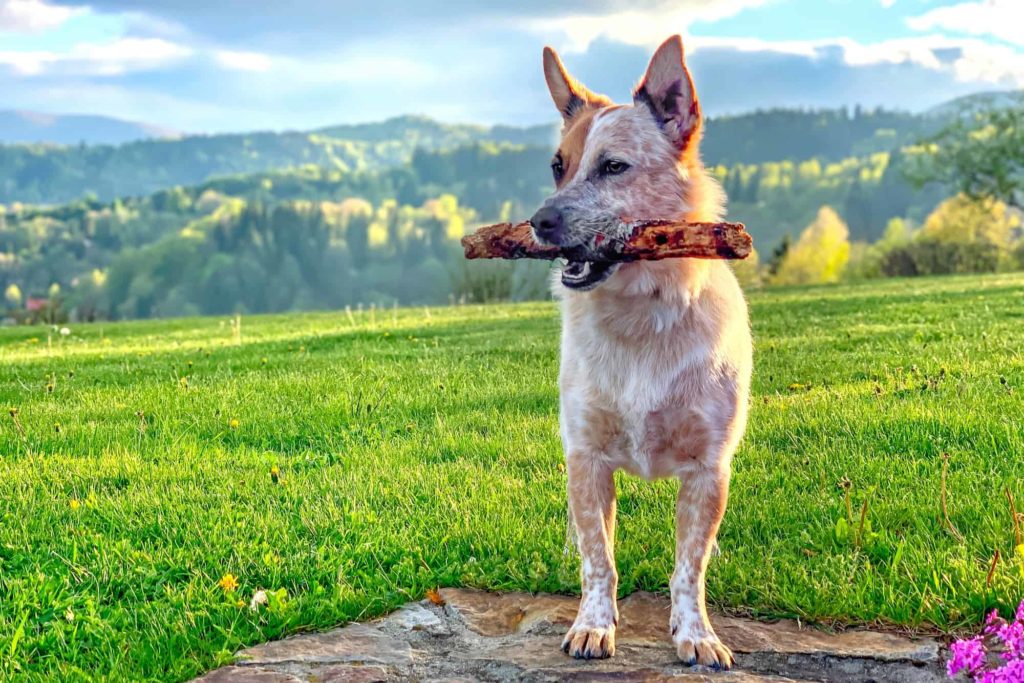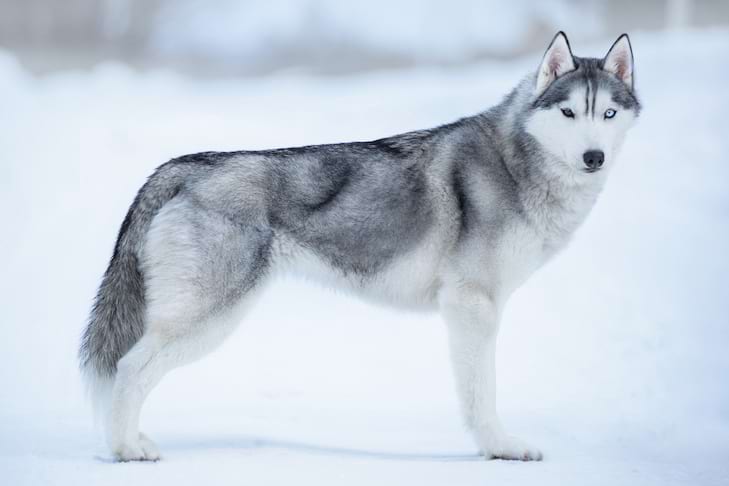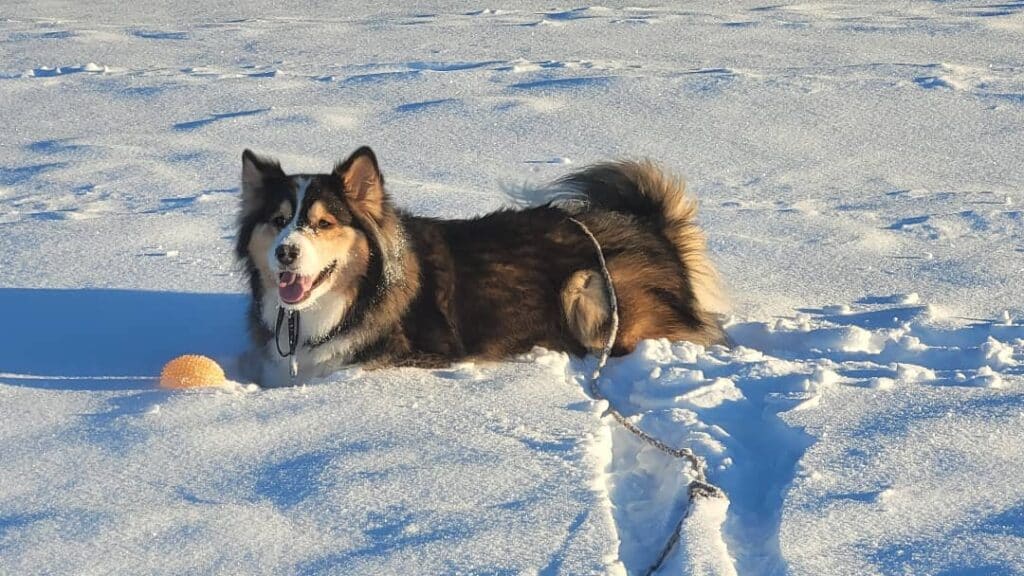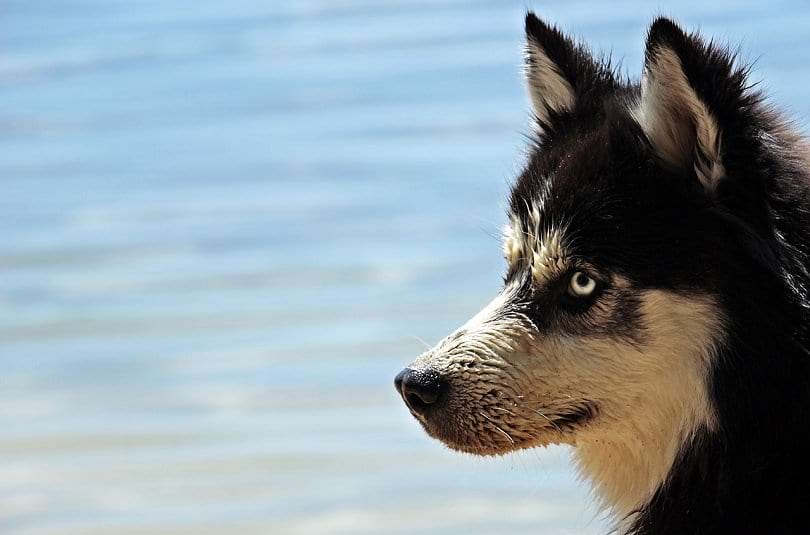If you’re searching for an active, intelligent, and loyal companion, consider a Blue Heeler Husky mix. Also known as the Australian Cattle Dog Siberian Husky mix, this is a crossbreed between two distinct and fascinating species, resulting in a unique combination of traits that can make for an incredible canine companion.
In this article, we will explore the characteristics, temperament, and needs of the Blue Heeler Husky mix, as well as some tips on caring for and training this unique breed. So, whether you’re a seasoned dog owner or considering adding a new member to your family, read on to discover more about the fascinating world of the Blue Heeler Husky mix.
Brief overview of Blue Heeler Husky Mix
| Weight: | 40 to 60 pounds |
| Height: | 18 – 24 inches |
| Lifespan: | 11 to 15 years |
| Apartment living: | No, do well in a home with a large backyard |
| Tolerate being alone: | No, suitable for active families |
| Coat: | Thick double coat |
| Level of shedding: | Moderate to High, brushing at least once or twice per week is required, daily brushing during shedding season |
| Temperament: | Stubborn, independent, smart, aggressive, protective, hardworking, energetic, lively |
| Suitable for new owners: | No |
| Exercise needs: | High, at least 1 to 2 hours of exercise a day is required |
| Dog and Cat friendly: | No, early socialization is required |
| Kids friendly: | No, Suitable for families with older kids, socialization is required |
| Price: | $600 to $1400 |
What is a Blue Heeler Husky Mix?

The Blue Heeler Husky Mix, also known as the Auskie, is a blend of the Siberian Husky and Australian Cattle Dog. Energetic and intelligent, they need ample stimulation and can be great watchdogs.
While friendly, their prey drive and nipping tendency might not suit homes with small children or pets. However, early training can manage these traits.
Parent Breeds of Blue Heeler and Husky Mix
The Ausky, an intriguing breed born from the calculated union of the Blue Heeler, formerly designated the Australian Cattle Canine, and the husky, renowned for their prodigious capabilities.
But let’s take a step back and delve deeper into the historical underpinnings and idiosyncratic behavioral traits of these canine progenitors to unravel the enigma of your fascinating mixed-breed pup.
Blue Heeler

In the ruggedly inhospitable terrain of the Australian Outback, the Blue Heeler burgeoned as a breed, honed to a fine edge as a tenacious livestock herder. However, the evolutionary genesis of the Australian Cattle Dog involved protracted experimentation with a sundry assortment of breeds. As such, it is evident that the Blue Heeler is, in essence, a mixed breed in and of itself.
Cerebral acumen is a hallmark trait of the Australian Cattle Dog, allowing for the swift resolution of complex quandaries while in motion. However, the relentless tenacity demanded by the profession of herding obstinate livestock can manifest as stubbornness in the dog’s demeanor.
The Australian Cattle Dog is renowned for its proprietorial inclinations, sometimes extending to a penchant for belligerence towards other canines. Ergo, proper socialization of your Blue Heeler Mix pup is paramount.
Siberian Husky

Amidst the pantheon of working dogs, the Siberian Husky finds his niche, harnessed for the arduous task of sled-pulling. Revered for his unmatched fortitude, celerity, and sagacity, this breed reigns supreme.
The Siberian Husky, also endowed with an inclination for gregarious familial camaraderie, once abetted the nomadic population of Chukchi in weathering the frigid tempests of northeastern Siberia, where the integrity of his unparalleled insulation capabilities was put to the test.
Throughout the sultry summer months, the Siberian Husky indulged in the unrestrained pursuit of prey, a quirk that reverberates even today in the modern breed.
For those harboring a preference towards the amalgamation of breed diversity, the prospect of the Dachshund Husky mix may pique your curiosity, replete with necessary information regarding the breed’s temperament and care.
How Does a Australian Cattle Dog Husky Mix Look Like ?
Size, height, and weight
The Blue Heeler Husky Mix, or Ausky, has an intriguing size, height, and weight. Male and female Auskies have comparable physical traits when fully developed. They are mid-sized, compact dogs with well-built medium-sized bodies.
When a Blue Heeler Husky Mix attains total growth, males and females can stand 20 to 23 inches (51 to 58 cm) tall. The full-grown size of the Blue Heeler Husky Mix is medium.
Regarding weight, a healthy female Ausky weighs around 34 to 62 pounds, while males weigh 35 to 64 pounds. The importance of the Blue Heeler Husky Mix varies depending on their diet, activity level, and overall health.
Coat colors and types
The Husky Cattle Dog Mix has a diverse coat, inheriting colors from both the Australian Cattle Dog (blue, mottled, speckled, red) and the Siberian Husky (white, agouti, black, brown, gray, red, sable).
Their coat type is a medium, thick double coat, much like the Husky’s, and they’re known to shed heavily.
The mix’s coat color can be single, multi, or tri-colored, depending on the dominant parent gene. In essence, their appearance is a vibrant blend of both breeds.
They can exhibit some behavioral issues.
The Blue Heeler Husky mix is a unique blend that can present challenges. Untrained, they can be aggressive and overly protective, not always ideal for families. Training is crucial to harness their loyalty and friendliness.
They might also exhibit herding tendencies with children.
While the Husky side brings friendliness, it also introduces stubbornness, making training a task. This mix is a rewarding pet but requires attentive care.
They are a working dog rather than a family dog.
This Husky Heeler hybrid is not only sometimes the best option for a family dog for a few reasons.
- Firstly, their temperament can make them prone to behavioral issues around young children.
- Secondly, their high energy levels and need for activity can make them challenging to manage in a family home.
However, these traits make them an excellent fit for working on farms and ranches, where they can work long hours and utilize their intelligence and skills as herding dogs, sled pullers, and agility performers. Additionally, their natural impulse to wander can be a problem in family homes that do not have secure boundaries.
Are Blue Heeler Husky Mixes aggressive?
Blue Heeler Husky Mixes aren’t naturally aggressive. However, early training and socialization are crucial to ensure they grow up well-adjusted. Their high energy can sometimes be mistaken for aggression, but it’s more about their zest for life. They might show protective tendencies, especially around their loved ones or when they sense a threat.
The key is to keep them engaged and active, as boredom can lead to unwanted behaviors. So, while they’re not typically aggressive, they do need consistent training and plenty of activities to channel their energy positively.
Do Blue Heeler Husky Mixes bark a lot?
The barking tendencies of Blue Heeler Husky Mixes can vary, but with the right training from a young age, their barking can be managed. It’s essential to establish yourself as the pack leader and maintain consistency in training.
Techniques like crate and leash training, combined with positive reinforcement, can be effective in controlling excessive barking. So, while they have the potential to bark, the frequency and intensity largely depend on the training and guidance they receive.
Training

Training a Blue Heeler Husky Mix dog is not a walk in the park. This hybrid breed has a strong herding instinct that must be curbed early in training. It would help if you immediately stop any attempts at herding members of your family.
The good news is that these dogs are brilliant, meaning they should be able to learn commands and tricks quickly. However, training this breed can be challenging, so you should be patient and persistent in your training methods. Positive reinforcement is the key to success, whether you’re working on leash training, barking, or housebreaking.
To bring out the best in your Blue Heeler Husky, it’s essential to establish yourself as the pack leader. It would help if you were a solid and authoritative presence in your dog’s life. Consistency is also crucial to training, so you should establish and stick to a regular training regimen.
Socialization is also critical for this breed. Proper socialization can help reduce the tendency to herd children and other animals and help your puppy develop into a well-behaved adult dog comfortable in various situations. With time, patience, and positive reinforcement, you can train your Blue Heeler Husky Mix to be a well-behaved and loving companion.
Exercise Requirements
The Husky and Australian Cattle Dog mix is a highly active and energetic dog with a great love for physical activities and playtime. Owners must provide physical exercises and mental stimulation to keep this crossbreed happy and healthy.
These dogs require a minimum of one to two hours of daily exercise, including walks, playtime, and running around. While taking them for walks is excellent, owners should allow them to run and play in a fenced-in yard or engage in fun games like Fetch and Frisbee.
These pups will likely get bored without enough exercise and start chewing on furniture or carpet. To avoid this, provide them with plenty of chew toys for mental stimulation during extended periods of alone time.
This crossbreed has a thick double coat, and owners need to brush their coats regularly to prevent tangles and remove dead hair. Shedding is also common, so investing in a furminator and vacuuming is necessary. Bathing should be done when required, and owners can use quality deodorizing wipes to keep their skin correctly conditioned.
In addition to physical care, owners should trim their dog’s nails every month and brush their teeth regularly to prevent bad breath, tooth decay, and gum disease.
Living conditions
The Blue Heeler and Husky Mix is a highly energetic and active breed that thrives on challenges and exercise. They require larger homes with ample space to run and play, preferably with a big yard to explore. However, if you want your furry friends to have free reign in your backyard, ensure you have the proper fencing installed.
Some areas may have zoning laws prohibiting physical fences, so a wireless dog fence is handy. This type of fence will keep your pets safe and secure within the boundaries of your property.
An electronic dog door is an excellent solution for pet owners wanting to give their furry friends more freedom and independence. With this device, your dogs can come and go as they please, and you can program it to set curfew hours for them. This way, you won’t be interrupted every hour to let them in or out, and you can continue your day uninterrupted.
Grooming and Cleaning
The dog has a thick double coat, which makes it perfect for colder environments. However, if you live in a warmer area, you may need some help.
Unfortunately, this breed is not hypoallergenic, which can be a real issue for those with allergies. It would help if you brushed your coat daily to prevent tangles and dead hair during shedding season.
This dog sheds a lot, so you’ll need to invest regularly in a furminator and vacuum to keep your home clean.
The Husky Blue Heeler mix can come in different colors. Depending on the Husky parent, some dogs will have paler coats, while others will have merle tri-color coats from the heeler genes.
It would be best to be careful not to overdo it when bathing, as it can dry out your skin. A better option is to use high-quality deodorizing wipes to keep their coat clean and conditioned.
Also, remember their nails. It would help if you trimmed them at least once a month to prevent cracking and discomfort.
Lastly, brush your dog’s teeth regularly to avoid bad breath, tooth decay, and gum disease. It’s essential to keep your furry friend healthy and happy.
Are Blue Heeler Husky Mixes Hypoallergenic?
No, Blue Heeler Husky Mixes aren’t the best choice for those with allergies or sensitivities to dog hair and dander. While regular grooming, brushing, and bathing can help manage shedding and maintain a clean coat, it won’t eliminate the allergens completely.
To further minimize allergens, it’s a good idea to keep both the dog’s sleeping area and your home clean. So, if allergies are a concern, you might want to consider other breeds or take preventive measures to reduce allergens in your environment.
Food and Diet
How do you keep your Ausky happy and healthy? A daily intake of 2 to 3 cups of high-quality dog food is necessary, so you should feed your dog two to three times daily.
But be careful not to overdo the treats, as they may lead to obesity. As a rule, treats should account for no more than 10% of your dog’s daily diet.
Consider investing in kibble that contains Omega-3 and Omega-6 fatty acids for healthy skin and a lustrous coat. However, even with a high-quality diet, your dog may still need more essential nutrients.
That’s why it’s recommended to add probiotics to your dog’s diet to promote the health of his liver and kidneys. Additionally, frozen carrots can serve as excellent dog chew toys, improving their dental health. Plus, carrots are high in vitamin A, fiber, and potassium.
Finally, always provide fresh water for your dog to aid digestion and nutrient absorption and keep him refreshed and relaxed.
Common Health Issues

As your Blue Heeler Husky Mix ages, it may be more susceptible to developing health problems. It’s essential to watch your furry friend closely and schedule regular check-ups with their vet.
It’s not just mixed breeds that may face health issues, but purebred dogs. Knowing the common health problems of your dog breed can help you provide them with the best possible care.
Now, let’s discuss some common health problems that Blue Heeler Husky Mix may experience. Here are a few examples:
1. Heatstroke
The Blue Heeler Husky Mix may struggle with heatstroke due to their thick double coat. They are much better suited to cold weather, and owners should take extra precautions during hot summer months to ensure their furry friends do not overheat. It’s essential to know the signs of heatstroke, such as excessive panting, drooling, and lethargy. If you suspect your dog is suffering from heatstroke, taking action immediately is essential to prevent serious health consequences.
2. Cataracts
As Blue Heeler Husky Mixes age, their vision may start to worsen due to a condition called cataracts.
3. Progressive retinal atrophy
Canines with a Blue Heeler Husky Mix may develop progressive retinal atrophy as they age, which causes the eye’s retina to deteriorate, and may result in loss of vision.
4. Deafness
As your Blue Heeler Husky Mix ages, it may experience a decrease in its hearing ability, potentially resulting in deafness.
5. Canine hip dysplasia
The Blue Heeler Husky Mix is susceptible to Canine hip dysplasia or osteoarthritis. It’s not just older dogs that can suffer from this condition; young ones are at risk too. But don’t despair if your puppy is diagnosed with hip dysplasia, as you can try various treatments and home remedies.
6. Osteochondrosis Dissecans
Osteochondrosis Dissecans, a devilish condition that plagues the Blue Heeler Husky Mix, is characterized by the loss of blood supply to the joints, which can cause bone death and may lead to joint issues.
How Long Does a Blue Heeler and Husky Mix Live?
Blue Heeler Siberian Husky Mixes are known to live for about 12 to 16 years. However, it would help if you remember that several factors can influence your dog’s lifespan. These factors may include their overall health, activity levels, and diet.
Therefore, keeping your furry friend in good health is essential by taking them for regular check-ups, feeding them a healthy diet, and providing enough exercise. Additionally, you must ensure that they are vaccinated and protected against any illnesses that may threaten their health.
Is this Blue Heeler Husky mix right for your needs?
The Blue Heeler Husky mix is a novel crossbreed that exudes loyalty, affection, and bonds with all family members and other canines. However, they do not take kindly to being left alone for long stretches and fare well when given well-defined boundaries, expectations, and a lot of activity.
This unique breed is well-suited to those who appreciate outdoor activities like hikes, walks, and running. It is the perfect solution for those who desire both Siberian Huskies and Australian Cattle Dogs but only have space for one, as it combines both breeds in a beautiful package.
Nevertheless, while these dogs are charming, potential pet owners must be prepared to invest time and resources into their upkeep. From feeding and training to exercise and socialization, the Blue Heeler Husky mix demands much attention, so it may only fit some.
List of dogs that are similar to Blue Heeler Husky mix
- Blue Heeler-Catahoula Mix
- Blue Heeler-Rottweiler Mix
- Blue Heeler-Australian Shepherd Mix
- Husky-Cane Corso Mix
- Husky-Doberman Mix
- Husky-French Bulldog Mix
- Husky-St Bernard Mix
- Husky-Greyhound Mix
Conclusion
In conclusion, the Blue Heeler Husky mix is a unique and fascinating breed with a winning combination of intelligence, loyalty, and athleticism. With their striking looks, high energy levels, and solid working instincts, these dogs are an excellent choice for owners looking for an active, engaging companion.
However, it’s important to remember that this breed has specific training, socialization, and exercise needs. By providing your Blue Heeler Husky mix with plenty of mental and physical stimulation and working with a professional trainer to develop a consistent and positive training routine, you can help your dog thrive and become a beloved family member. You and your Blue Heeler Husky mix can enjoy a fulfilling and rewarding life together with patience, love, and dedication.

Pingback: Blue Heeler Corgi Mix: Exploring the Fascinating World 2023
Pingback: Blue Heeler Catahoula Mix: A Unique Blend of Breeds 2023
Pingback: Blue Heeler Jack Russell Mix: Revealing Hidden Wonders 2023
Pingback: Blue Heeler Rat Terrier Mix: Revealing Hidden Wonders 2023
Pingback: Mini Blue Heeler: Interesting World Of Your Dog 2023
Pingback: Blue Heeler Chihuahua Mix: Revealing Hidden Wonders 2023
Pingback: Rottweiler Blue Heeler Mix: Dive into the Interesting World 2023
Pingback: White Husky: Dive into the Fantastic World of This Breed 2023
Pingback: Doberman Husky Mix: Fascinating Facts You Need to Know 2023
Pingback: French Bulldog Husky Mix: Dive into the Interesting World 2023